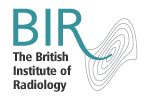British Institute of Radiology
The British Institute of Radiology (BIR) is a professional association and learned society dedicated to the field of radiology and radiation oncology. It is based in the United Kingdom and serves as a hub for professionals in the field, including radiologists, radiographers, medical physicists, and radiation oncologists.
History[edit | edit source]
The BIR was founded in 1897, originally as the "Roentgen Society," named after Wilhelm Röntgen, the discoverer of X-rays. It was the first radiological society in the world. In 1927, it merged with the "British Association of Radiologists" to form the British Institute of Radiology. This merger was aimed at unifying the efforts of professionals in the field to advance the science and practice of radiology.
Mission and Objectives[edit | edit source]
The mission of the BIR is to support the work of its members and to promote the advancement of radiology and radiation oncology. The objectives include:
- Providing high-quality education and training for professionals in the field.
- Promoting research and innovation in radiology and related disciplines.
- Facilitating the exchange of knowledge and best practices among its members.
- Advocating for the role of radiology in healthcare.
Activities[edit | edit source]
The BIR organizes a variety of activities to fulfill its mission:
Conferences and Events[edit | edit source]
The BIR hosts numerous conferences, seminars, and workshops throughout the year. These events cover a wide range of topics in radiology and provide opportunities for professionals to learn about the latest developments and network with peers.
Publications[edit | edit source]
The BIR publishes several journals, including the "BJR" (British Journal of Radiology), which is a leading international journal in the field. These publications are essential resources for professionals seeking to stay informed about the latest research and clinical practices.
Education and Training[edit | edit source]
The BIR offers a variety of educational resources, including online courses, webinars, and training programs. These are designed to support continuous professional development and ensure that practitioners are equipped with the latest knowledge and skills.
Membership[edit | edit source]
Membership in the BIR is open to individuals and organizations involved in radiology and related fields. Members benefit from access to educational resources, networking opportunities, and the ability to contribute to the advancement of the profession.
Related pages[edit | edit source]
Search WikiMD
Ad.Tired of being Overweight? Try W8MD's NYC physician weight loss.
Semaglutide (Ozempic / Wegovy and Tirzepatide (Mounjaro / Zepbound) available. Call 718 946 5500.
Advertise on WikiMD
|
WikiMD's Wellness Encyclopedia |
| Let Food Be Thy Medicine Medicine Thy Food - Hippocrates |
Translate this page: - East Asian
中文,
日本,
한국어,
South Asian
हिन्दी,
தமிழ்,
తెలుగు,
Urdu,
ಕನ್ನಡ,
Southeast Asian
Indonesian,
Vietnamese,
Thai,
မြန်မာဘာသာ,
বাংলা
European
español,
Deutsch,
français,
Greek,
português do Brasil,
polski,
română,
русский,
Nederlands,
norsk,
svenska,
suomi,
Italian
Middle Eastern & African
عربى,
Turkish,
Persian,
Hebrew,
Afrikaans,
isiZulu,
Kiswahili,
Other
Bulgarian,
Hungarian,
Czech,
Swedish,
മലയാളം,
मराठी,
ਪੰਜਾਬੀ,
ગુજરાતી,
Portuguese,
Ukrainian
Medical Disclaimer: WikiMD is not a substitute for professional medical advice. The information on WikiMD is provided as an information resource only, may be incorrect, outdated or misleading, and is not to be used or relied on for any diagnostic or treatment purposes. Please consult your health care provider before making any healthcare decisions or for guidance about a specific medical condition. WikiMD expressly disclaims responsibility, and shall have no liability, for any damages, loss, injury, or liability whatsoever suffered as a result of your reliance on the information contained in this site. By visiting this site you agree to the foregoing terms and conditions, which may from time to time be changed or supplemented by WikiMD. If you do not agree to the foregoing terms and conditions, you should not enter or use this site. See full disclaimer.
Credits:Most images are courtesy of Wikimedia commons, and templates, categories Wikipedia, licensed under CC BY SA or similar.
Contributors: Prab R. Tumpati, MD

